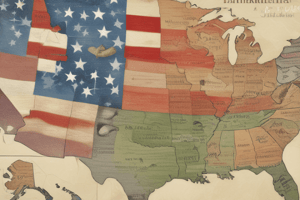Podcast
Questions and Answers
What was a major factor in South Carolina's economic decline in the early 1800s?
What was a major factor in South Carolina's economic decline in the early 1800s?
Tariffs that made imported manufactured goods from England extremely expensive
What was the significance of the Tariff of Abominations in 1828?
What was the significance of the Tariff of Abominations in 1828?
It led to South Carolinians threatening to secede from the Union
What was John C. Calhoun's response to the economic crisis in South Carolina?
What was John C. Calhoun's response to the economic crisis in South Carolina?
He proposed the idea of nullification, allowing states to declare federal laws invalid
What was the central issue debated by Senators Hayne and Webster in 1830?
What was the central issue debated by Senators Hayne and Webster in 1830?
What was Daniel Webster's stance on the Union in the 1830 Senate debate?
What was Daniel Webster's stance on the Union in the 1830 Senate debate?
What was the core message of Daniel Webster's statement on liberty and the Union?
What was the core message of Daniel Webster's statement on liberty and the Union?
What was the significant action taken by South Carolina in November 1832 in response to the tariff laws?
What was the significant action taken by South Carolina in November 1832 in response to the tariff laws?
How did President Jackson respond to South Carolina's nullification ordinance?
How did President Jackson respond to South Carolina's nullification ordinance?
What was the purpose of the Force Bill passed by Congress in 1833?
What was the purpose of the Force Bill passed by Congress in 1833?
What was the outcome of Senator Henry Clay's efforts to resolve the nullification crisis?
What was the outcome of Senator Henry Clay's efforts to resolve the nullification crisis?
What was the ultimate result of the nullification crisis?
What was the ultimate result of the nullification crisis?
Study Notes
South Carolina's Economic Decline
- South Carolina's economy began to decline in the early 1800s
- The state's residents blamed the nation's tariffs for the decline
Tariffs and Manufacturing
- South Carolina had few industries and imported manufactured goods from England
- Tariffs made these imports extremely expensive
The Tariff of Abominations
- The Tariff of Abominations was passed in 1828
- This led to South Carolinians threatening to secede from the Union
Nullification
- John C. Calhoun, the nation's vice president and a South Carolinian, proposed the idea of nullification
- Nullification allowed states to declare federal laws invalid
The Hayne-Webster Debate
- Senators Robert Hayne and Daniel Webster debated on the floor of the Senate in 1830
- Hayne championed states' rights, while Webster defended the Union
- Webster stated that liberty depended on the strength of the Union
- Webster famously declared, "Liberty and Union, now and forever, one and inseparable!"
Tariff Laws and Nullification
- In 1832, Congress passed a tariff law that cut tariffs significantly, but it did not satisfy South Carolinians.
- In November 1832, a special state convention in South Carolina adopted an ordinance of nullification, declaring the tariffs of 1828 and 1832 to be unconstitutional.
- President Jackson considered the nullification ordinance an act of treason and sent a warship to Charleston in response.
The Force Bill and Compromise
- In 1833, Congress passed the Force Bill, authorizing the president to use the military to enforce acts of Congress.
- Senator Henry Clay pushed through a compromise bill that lowered the nation's tariffs gradually until 1842.
- In response, South Carolina repealed its nullification of the tariff law.
Outcome and Resolution
- Both sides claimed victory, and the issue was laid to rest, at least temporarily.
- The compromise tariffs remained in place until 1842.
Studying That Suits You
Use AI to generate personalized quizzes and flashcards to suit your learning preferences.
Description
Learn about the economic decline of South Carolina in the 1800s, its effects on the state's residents, and the reaction to the Tariff of Abominations in 1828. Understand how this event contributed to the growing turmoil in the United States.




